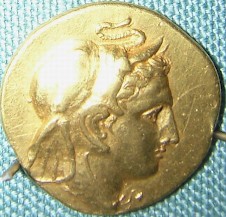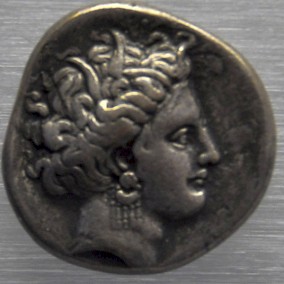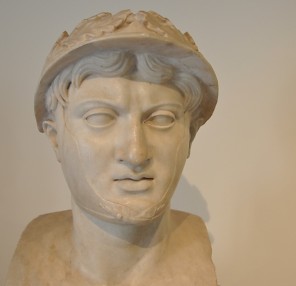History of Syracuse (4)
Q1954223Syracuse: the ancient capital of Sicily.
Losing Independence
The crisis of the year 354/344 was grave. There were revolutions in the cities of Sicily and southern Italy and effective government came to an end. Hicetas had liberated Syracuse from the tyranny of Dionysius II, who was isolated in the citadel in the Syracusan harbor. The citizens had invited Corinth, which had founded Syracuse three centuries before, to offer help expelling the tyrant, and had asked the same from Carthage, which recognized a chance when it saw one. It sent ships to support Hicetas and in the year 344/343, its diplomats concluded alliances with Italian towns (including an alliance with Rome). It was clear for all to see that after almost permanent civil war since 357, Greek Sicily would be conquered by the Carthaginians.
Yet, things turned out differently, because Syracuse's mother-city Corinth did indeed send an army to help its colony, commanded by the efficient Timoleon. At the same time, king Archidamus III of Sparta came to the assistance of Tarentum. As we will see, their arrival marked the beginning of an age in which the Greeks, subdued by the Macedonian king Philip II, the father of Alexander the Great, started to show interest in the far west again.
Timoleon's expeditionary force was made up from mercenaries who had gained experience in the Third Sacred War. Evading a Carthaginian interception force, Timoleon arrived at Tauromenium, met the army of Hicetas, and unexpectedly attacked the man who had invited him. He now opened negotiations with Dionysius and offered collaboration in the war against Carthage. Dionysius agreed, allowed Timoleon's troops to enter Ortygia, beat off his enemies, and found himself outsmarted by Timoleon. In the summer of 343, Dionysius II accepted an offer to settle in Corinth and disappeared from the Sicilian scene.
Now, Timoleon could start with a project of recovery. Thousands of Greeks responded to his invitation to come to Sicily, accept grants of land, and repopulate the cities. (Their number is estimated at 60,000.) At the same time, Timoleon continued the war against Carthage and defeated his enemy at the river Cremisus, in the interior of the island. (During this war, Carthage for the first time employed Greek mercenaries on a large scale.) A peace treaty was signed between Syracuse and Carthage in 339, and two years later, the other towns joined in, at about the same time as the cities of Greece proper and Philip of Macedonia signed the collective peace treaty of Corinth. The border with the Carthaginian territories was to be the river Halycus again.
Timoleon celebrated his victory with an emission of coins showing Zeus Eleutherius, "Zeus the Liberator". At Syracuse, he reorganized the constitution, mixing elements of democracy, oligarchy, and monarchy. It was meant as a solid foundation for stability, peace, and prosperity, and indeed, Sicily saw a generation of peace.
Having accomplished his mission, Timoleon retired from public life as the second founder of the city, which restored its fortunes and wealth. Later generations were inspired by his western adventures, and already in 334 the king of Epirus, Alexander of Molossis (the brother-in-law of Alexander the Great) followed Timoleon's example and helped the Greeks of southern Italy ward off the native tribes.
So, Sicily prospered. Fear for Alexander the Great, who had plans to come to the west, may have inspired the Sicilians to refrain from internal fights. But after his death in 323, old tensions resurfaced. In Syracuse, the old inhabitants and the people who had been settled in Sicily by Timoleon could not stand each other. The conflict focused on the question whether Syracuse's mixed constitution should become more oligarchic or more democratic. In 316/315, a general named Agathocles defeated the oligarchs and became sole ruler (a remarkable twist in his democratic career).

The tyrant played the familiar old tune: he was supported by an army of mercenaries, tried to expand Syracuse's power by subduing the other Sicilian towns (this time Acragas, Gela, Messana), and when his popularity fell, provoked a war against Carthage. In 311, Agathocles was defeated near Himera, and the Carthaginians laid siege to Syracuse. Although this city was strongly fortified, Agathocles had no effective army, and he decided upon a remarkable gamble: in August 310, he sailed away from Sicily, and invaded the Carthaginian homeland. Here, he won a brilliant victory, and he proceeded against the enemy capital itself.
At this stage, he concluded a treaty with Ophellas, a former officer of Alexander the Great who had made himself ruler of Cyrenaica. He was to bring new mercenaries to Agathocles, and in return would be made Agathocles' governor at Carthage. In the autumn of 308, these forces were added to those of Agathocles, who had his savior assassinated as soon as possible. The mercenaries had little choice and sided with Agathocles, who left them behind, returned to Sicily, and concluded a peace treaty with Carthage that left him in control of Sicily east of the Halycus (306). The mercenaries, left alone, were killed by the Carthaginians.

Agathocles, now ruler of a large part of Sicily and controlling formerly independent Greek cities, proclaimed himself king when he heard that in the east the Successors of Alexander (Antigonus, Demetrius, Ptolemy) had done the same. He was recognized when he married a stepdaughter of Ptolemy, and now tried to expand his kingdom to southern Italy. His daughter Lanassa married to king Pyrrhus of Epirus. Unfortunately, our main source, Diodorus of Sicily, does not describe these events. What is certain, however, is that he was unhappy with his family, did not want his sons to succeed him as king, and restored the Syracusan democracy on his death bed (288).
The reign of Agathocles, perhaps the most ruthless and certainly the most successful of all Syracusan tyrants, marks the last time that Sicily played an important and independent role in the history of the Mediterranean world. Inevitably, after his death, there was a period of anarchy. In the next century, the island was contested between Epirus, Rome, and Carthage.
One problem was that after the coup of Dion (above), the native towns of Sicily and Italy were no longer checked. Timoleon and Agathocles had been able to restore order on Sicily, but in Italy, the natives were definitely on the rise, having started to imitate Greek political structures, having built cities of their own, having made military progress, and having started to imitate Greek architecture. (On Sicily too: Segesta, for example, boasted a Greek-style temple.)
The Italian nations now had much in common with the Greeks and it is easy to overestimate the cultural consequences of their successful wars against the Greek cities of southern Italy. Still, the Greeks had an understandable fear of their northern neighbors and had already invited king Archidamus III of Sparta, king Alexander of Molossis and Timoleon to defend them.
Another problem was the rise of Rome, which had defeated its main opponents in the battle of Sentinum (295) and had entered the backyard of Tarentum when it founded a colonia at Venusia (291). In 285, Thurii felt itself threatened by the native Lucanians. Agathocles was no longer alive - he had died in 288 - and Syracuse could not protect the Greek city because it was at war with the Carthaginians, who were rapidly advancing to the east. Therefore, Thurii was forced to ask for help from Rome, which did what was demanded and gained valuable experience in the deep south. In 282, Thurii and Rhegium repeated the request. Again, Rome supported the Greek towns, but this time, it stationed garrisons in the cities. The Tarentines, who had always claimed the hegemony over the Greek towns in Italy, understood that they were losing status, and decided to strike at Rome before it was too late.

They received support from Pyrrhus of Epirus, a powerful warrior king who wanted to repeat in the west what Alexander the Great had done in the east, and a son-in-law of king Agathocles of Syracuse. Initially, Pyrrhus was successful and defeated the Romans twice, but the Roman diplomats replied with a treaty with Carthage. From now on, both sides would cooperate in a war against the Greek towns. This forced Pyrrhus to go to Sicily (278), where he was again very successful. Yet, his success became his undoing: his Syracusan allies wanted to remain independent and did not like becoming subjects of the Epirote king. Syracuse revolted, and Pyrrhus left Sicily to its own devices. In 276, he returned to Italy, where he was defeated by the Romans, who had in the meantime learned how to deal with Pyrrhus' elephants. Defeated on both fronts, the king returned to Greece, leaving Italy to Rome and Sicily as a cockpit for Rome and Carthage to fight in.
When the Romans besieged Tarentum in 272, a Carthaginian navy appeared to support the Greeks. This was seen as a breach of the treaty and the alliance was canceled. A few years later, the Romans decided to declare war after an incident in Messana.
This town had been occupied by former Syracusan mercenaries, called the Mamertines. In 265, the tyrant of Syracuse, Hiero II, defeated them and laid siege to the city. Immediately, the Mamertines asked help from Carthage, which gladly intervened and sent its admiral Hannibal to defend and garrison Messana. From now on, the Carthaginians controlled the Strait. However, occupation was not the help the Mamertines had been hoping for. Rome received a call for help too, and decided to intervene, running the risk of full-scale Carthaginian intervention. But Rome could not ignore the request: from Messana, the Carthaginians threatened the Greek towns of southern Italy's, Rome's new allies. War was inevitable, and the independence of Syracuse was soon to be over.